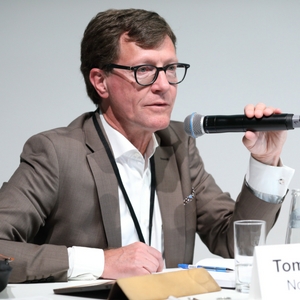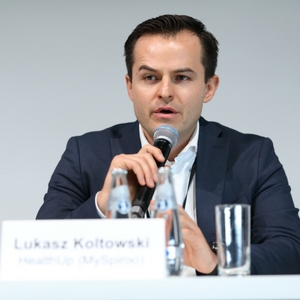Digital Health faces formidable hurdles in chronic disease management

Bringing healthcare into the digital age would create a greenfield opportunity, opening vast opportunities for devices and drugs. Yet before companies can start open field running through the sector, they face a series of formidable hurdles that must be overcome: patient acceptance, adoption by physicians, integration with healthcare systems and payers willing to pay.
At BIO-Europe® 2017 in Berlin, the first Digital Health Day featured a panel of executives leading the industry in the "Digitization of Chronic Condition Management."
Tomas Landh, Innovation Sourcing VP and Senior Principal Scientist for Novo Nordisk, leads what he described as a very large team working on digital health for diabetes, the area where digital health is most developed in chronic disease.
 "We have launched applications, we are working with IBM Watson and our approach is extremely patient-focused. We have to listen to the patient; I am going to repeat this every time. Patient care is extremely personalized. There are so many patients with so many different backgrounds.
"We have launched applications, we are working with IBM Watson and our approach is extremely patient-focused. We have to listen to the patient; I am going to repeat this every time. Patient care is extremely personalized. There are so many patients with so many different backgrounds.
"Artificial Intelligence is great, and I like those words, but what I like better is seeing the patient take responsibility with what can be called Augmented Intelligence, where patients are more in control of their data. Mining data is wonderful and has great promise. But talking to diabetic patients you learn they are pretty scared by Big Data. They feel conflicted. It is more complex than worrying about privacy issues or security. They worry about what is behind the algorithms. They wonder if the physician is not making decisions anymore about how to treat them. It is a scary thought for them."
According to Lukasz Koltowski, CEO for HealthUp that developed MySpiroo, a personal, connected, handheld spirometer, "One of the reasons digital solutions have not succeeded is that they are not beautiful, they are not user friendly, asking questions that patients do not understand.
"The market for consumer electronics has shown that if the customer can open the box and start using the product, it will succeed and those that cannot will fail. They just do it. We have to learn how to do this, we have to pull in the people who understand this approach, designers, psychologists, and most of all the patients themselves," he said.
 "Unique to medical care is a further requirement that patients need to know there is a person behind the machine. Even if it is true that bots are delivering the same scripted answers that physicians themselves deliver, physicians are seen as partners by patients, providing empathy, an understanding," said Koltowski.
"Unique to medical care is a further requirement that patients need to know there is a person behind the machine. Even if it is true that bots are delivering the same scripted answers that physicians themselves deliver, physicians are seen as partners by patients, providing empathy, an understanding," said Koltowski.
Rana Lonnen, the lead for Search and Evaluation Strategic Venture Capital at Novartis Pharma, agreed that "where technology companies succeed is in being really innovative for the consumer, getting very close to the consumer, understanding what their customer wants. They apply techniques and innovation that really deliver a product the consumers love and want to use. And they have the economies of scale distributed across all of their markets.
"We do not have the core capabilities internally to be in the tech space. This is the reason some years ago we started working with Verily on contact lenses and then developed the relationship further. This is what we have seen in our partnership with Qualcomm," she said.
At some point in a near future, she said, the consumer approach to personal health devices and the medical approach to patient management through devices will come together.
"What the technology companies lack is an understanding of the disease, of the regulatory environment, which are things we understand very well. We are talking about serious diseases and how they affect people, except that for a long time our approach has been to make a drug and give it to the patient. Moving into the new environment we need to be closer to the patient; we now need to understand what the patient wants, to look at the whole patient journey, understanding as the technology companies do about keeping the patient engaged. Why not create something they want to use, that they love to use?" said Lonnen.
Landh said he fully agrees about the patient journey, adding, "There are patient management solutions using games that are pointing to the success of offering rewards for the patient once they are compliant.
"But we need more than an Apple watch," he said. "The tech companies need us, and the biotech and pharma companies are aligning with them, successfully so. But the payers are not yet part of this and there are definitely political decisions required. Governments need to step up because chronic diseases are going to empty the treasuries. Yet I am not sure they realize this, and though there are a lot of papers on this topic and many discussions, it is not easy to convince them that it can be less expensive than paying for the complications, which has been proven beyond any doubt."
According to Koltowski, one of the ways to get these new technologies into healthcare systems is through clinical trials, yet so far there are few clinical trials that are positive for digital health. This makes the conversation difficult with payers because they do not see a cost effectiveness for digital health in the data analysis, leaving us with few arguments for digital health.
"The other issue is that these technologies are potentially cost-effective in the long-term, but the payers are looking at short-term metrics, such as half-year mortality or 30-day readmission rates. Digital health through clinical trials must demonstrate these short term results that payers are willing to pay for, which is super difficult. We need technologies who can do this, and then run the trials," he said.
Digital medicine companies need a business strategy to ensure their innovative ideas will get to market and to work together with other industry stakeholders to make the biggest impact. Make the necessary connections with decision makers and investors from the life sciences sector by attending Digital Medicine & Medtech Showcase, January 8-10, in San Francisco.
